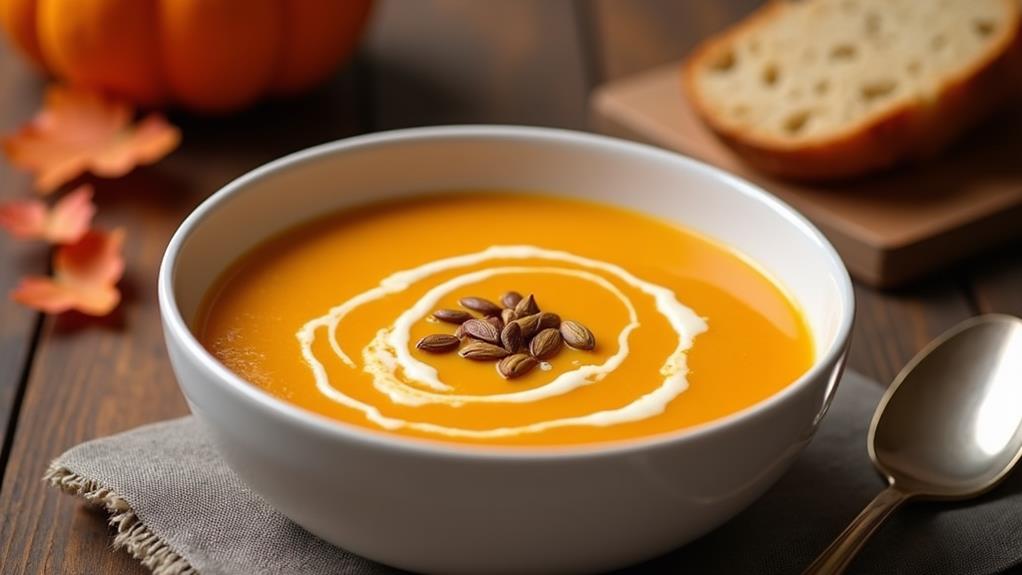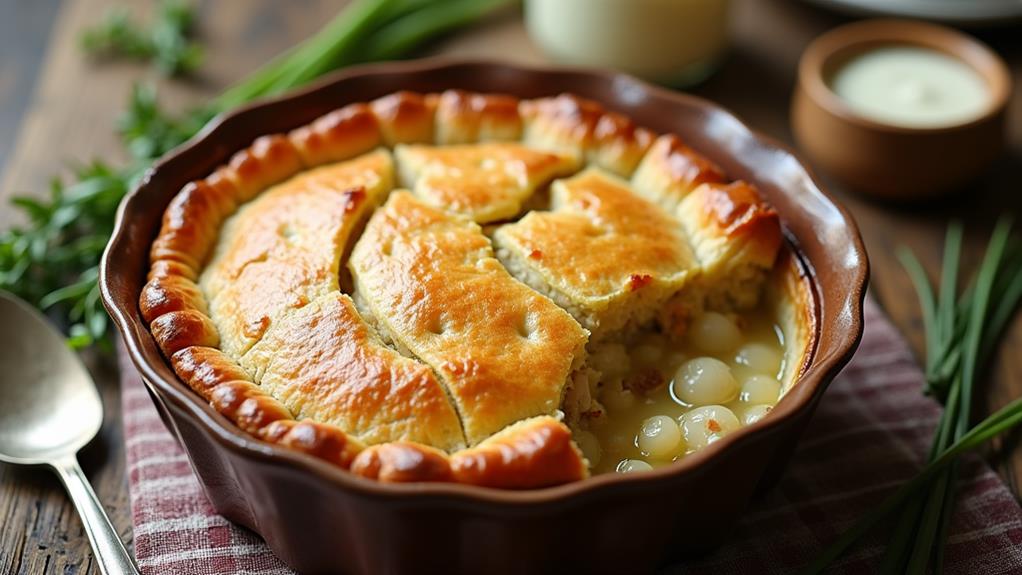You've probably encountered butternut squash soup on a chilly autumn day, its warm aroma and velvety texture instantly comforting. But have you ever considered the rich history behind this beloved dish? From its Native American roots to its modern-day adaptations, butternut squash soup has evolved into a versatile culinary staple. Whether you're a seasoned chef or a curious food enthusiast, there's more to this simple soup than meets the eye. Let's explore the origins, preparation techniques, and creative twists that make butternut squash soup a perennial favorite on tables around the world.
Key Takeaways
- Butternut squash soup is a creamy, comforting autumn dish made with squash, onions, broth, and cream.
- The basic recipe involves sautéing onions, simmering squash in broth, and pureeing until smooth.
- Nutmeg and cinnamon can enhance the soup's warm, autumnal flavors.
- The soup can be easily adapted for vegan preferences by substituting cream with alternatives like coconut milk.
- Leftovers can be refrigerated for up to a week or frozen for longer storage while maintaining quality.
History
The origins of butternut squash soup can be traced back to Native American cuisine. Indigenous peoples cultivated squash as one of their "Three Sisters" crops, alongside corn and beans, long before European colonization. They'd use various types of squash in soups and stews, laying the foundation for what would eventually become butternut squash soup.
As European settlers arrived in North America, they adopted and adapted many Native American culinary practices. You'll find that squash soups gained popularity in colonial America, often featuring pumpkin or other winter squash varieties.
The butternut squash, however, didn't make its debut until the 1940s. It was developed by Charles Leggett in Stow, Massachusetts, as a cross between gooseneck squash and hubbard squash.
Following its introduction, butternut squash quickly became a favorite ingredient in soups due to its sweet flavor and smooth texture. You'll notice that modern recipes often incorporate spices like nutmeg and cinnamon, reflecting the influence of both Native American and European culinary traditions.
Today, butternut squash soup remains a beloved autumn staple in many households and restaurants across North America and beyond.
Recipe
Butternut squash soup is a comforting autumn favorite that warms the soul on chilly days. Its velvety texture and rich, slightly sweet flavor make it a perfect appetizer or light meal.
This simple recipe focuses on the pure, natural taste of butternut squash, enhanced by a few complementary flavors. With just five ingredients, you can create a luxurious soup that tastes like it came from a gourmet kitchen.
- 1 large butternut squash (about 3 pounds or 1.4 kg), peeled, seeded, and cubed
- 1 medium onion, chopped
- 4 cups (946 ml) vegetable broth
- 1/2 cup (120 ml) heavy cream
- 2 tablespoons (30 ml) olive oil
- Salt and pepper to taste
In a large pot, heat the olive oil over medium heat. Add the chopped onion and sauté until translucent, about 5 minutes. Add the cubed butternut squash and vegetable broth, bringing the mixture to a boil. Reduce heat and simmer for 20-25 minutes or until the squash is tender.
Remove from heat and use an immersion blender to puree the soup until smooth. If you don't have an immersion blender, carefully transfer the soup to a standard blender in batches. Once smooth, stir in the heavy cream and season with salt and pepper to taste. Reheat gently if needed before serving.
For the best flavor, choose a butternut squash that feels heavy for its size and has a matte, rather than glossy, skin. If you prefer a thinner consistency, add more broth or water.
To make this soup vegan, substitute the heavy cream with coconut milk or cashew cream. For added depth of flavor, consider roasting the squash before adding it to the soup, or garnish with a sprinkle of nutmeg or cinnamon before serving.
Cooking Steps
To create this comforting soup, you'll begin by sautéing onions until they're translucent. Then, add cubed squash and broth to simmer until tender.
Once the squash is soft, you'll puree the mixture until smooth, either with an immersion blender or by carefully transferring it to a standard blender.
Step 1. Sauté Onions Until Translucent
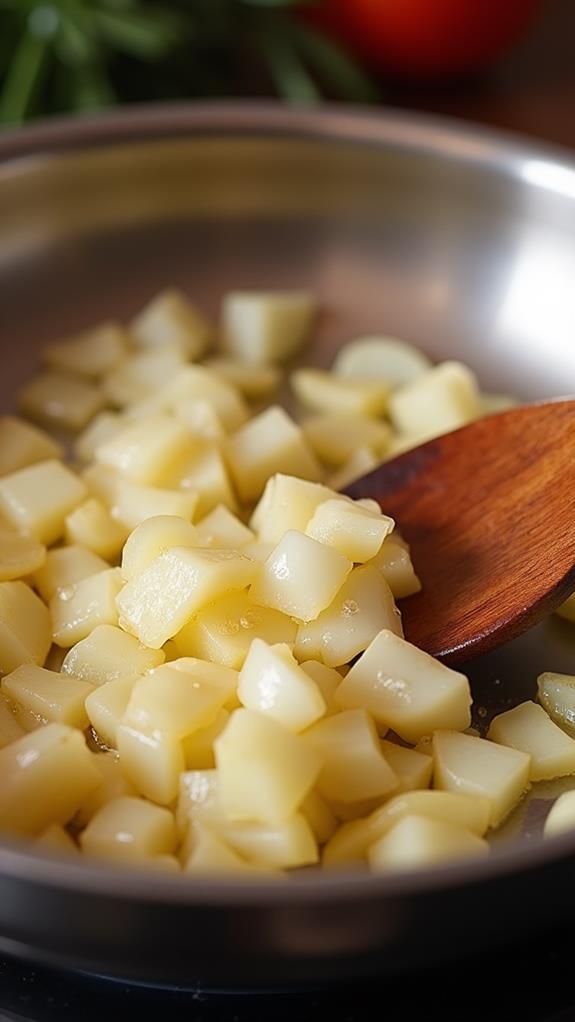
Begin by heating the olive oil in a large pot over medium heat.
Once the oil shimmers, it's time to add your chopped onions. Spread them evenly across the bottom of the pot, ensuring they're in a single layer. This allows for uniform cooking and prevents burning.
As the onions cook, you'll notice them start to soften and become aromatic. Stir them occasionally with a wooden spoon or spatula to prevent sticking and promote even cooking. You're aiming for a translucent appearance, which typically takes about 5 minutes.
During this process, the onions will release their natural sugars, developing a subtle sweetness that'll enhance your soup's flavor profile.
Keep a close eye on the onions as they cook. If they begin to brown too quickly, lower the heat slightly. You want them to become soft and translucent, not caramelized or crispy.
Once they've reached the desired translucency, you're ready to move on to the next step in creating your delicious butternut squash soup.
Step 2. Add Squash and Broth
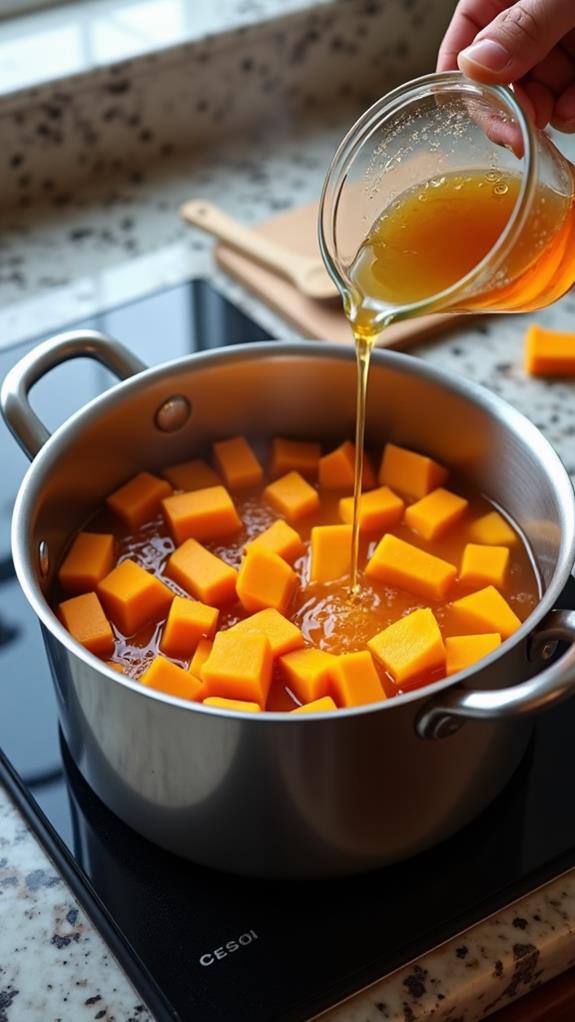
With your onions perfectly translucent, it's time to introduce the star of the show: butternut squash.
Add the cubed squash to your pot, ensuring each piece has been peeled and seeded beforehand. The vibrant orange cubes will contrast beautifully with the softened onions, creating a visual preview of the soup's rich color.
Next, pour in the vegetable broth. You'll need 4 cups, which will provide enough liquid to cook the squash and create the soup's base. As you add the broth, you'll notice it barely covers the squash pieces – this is perfect. The concentration of flavors will intensify as the squash cooks and softens.
Bring this mixture to a boil over medium-high heat. You'll see small bubbles forming around the edges of the pot, gradually increasing until the entire surface is bubbling.
Once boiling, reduce the heat to low, allowing the soup to simmer gently. This slower cooking process will help the squash become tender without breaking apart too quickly, ensuring a smooth texture when blended later.
Step 3. Puree Until Smooth
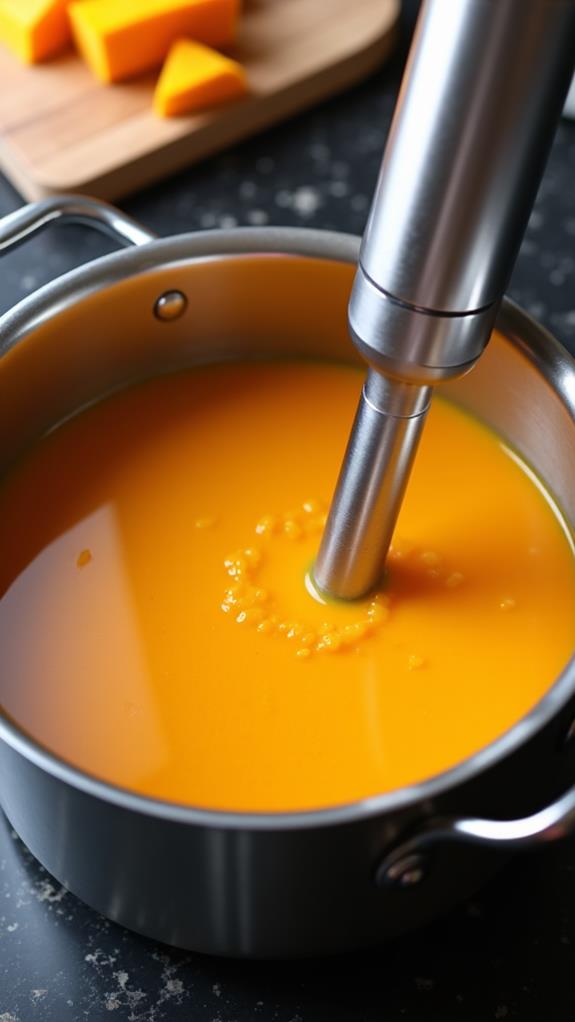
After simmering for 20-25 minutes, your butternut squash should be fork-tender.
Now it's time to transform your pot of ingredients into a silky-smooth soup. Remove the pot from the heat and let it cool slightly for a few minutes. This will make the blending process safer and easier to manage.
If you have an immersion blender, you're in luck. Simply insert it into the pot and blend until the soup reaches a velvety consistency. Be sure to move the blender around to catch any chunks that might be hiding.
If you don't have an immersion blender, don't worry. You'll need to transfer the soup to a standard blender in batches. Fill the blender no more than halfway, secure the lid, and pulse a few times before blending continuously.
Remember to hold the lid down with a kitchen towel to prevent any hot splashes. Once each batch is smooth, pour it into a clean pot or bowl.
Continue this process until all the soup is pureed. You'll be rewarded with a luxuriously smooth butternut squash soup that's ready for the final touches.
Step 4. Stir in Heavy Cream

The final step to achieve a luxuriously creamy butternut squash soup is stirring in the heavy cream. You'll want to add 1/2 cup (120 ml) of heavy cream to your pureed soup. Be sure to remove the pot from heat before doing this to prevent the cream from curdling. As you pour in the cream, stir continuously to ensure it's evenly distributed throughout the soup.
The heavy cream adds a rich, velvety texture and a subtle depth of flavor that complements the natural sweetness of the butternut squash. If you're looking for a lighter option, you can substitute half-and-half or whole milk, though the result won't be quite as creamy. For a dairy-free version, try using coconut milk or cashew cream instead.
Once you've stirred in the cream, taste your soup and adjust the seasoning as needed. Add salt and pepper to enhance the flavors.
If you'd like to reheat the soup before serving, do so gently over low heat, stirring occasionally to prevent scorching.
Step 5. Season and Reheat Gently
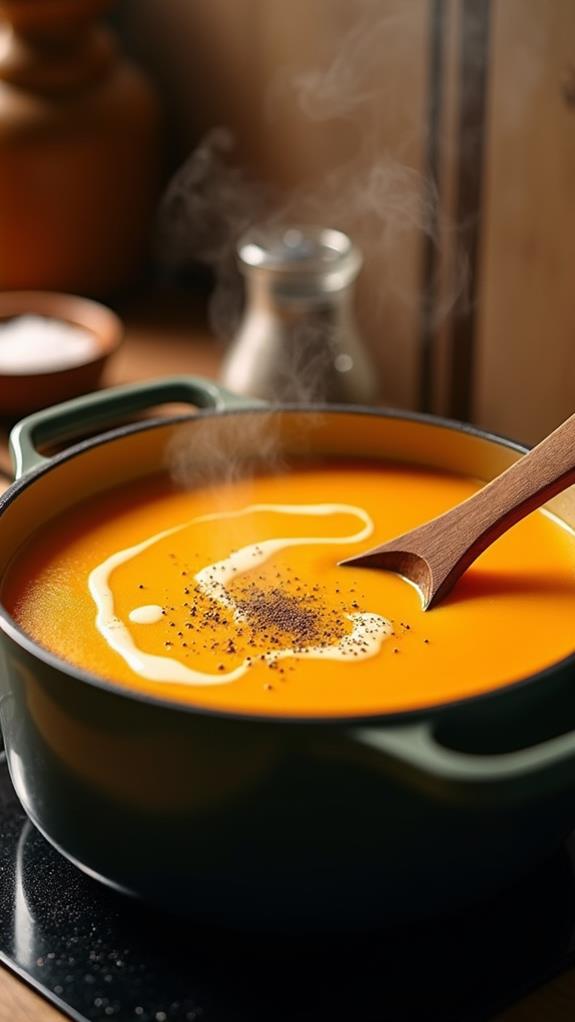
Seasoning your butternut squash soup to perfection is the final step before serving. Taste your soup and add salt and freshly ground black pepper as needed. Remember, you can always add more seasoning, but you can't take it away, so start with small amounts and adjust gradually.
If you'd like to enhance the flavor further, consider adding a pinch of nutmeg or cinnamon for a warm, autumnal touch.
Once you're satisfied with the seasoning, it's time to reheat your soup gently. Place the pot back on the stove over low to medium-low heat, stirring occasionally to prevent scorching.
Don't let the soup boil, as this can alter its smooth texture and potentially curdle the cream. Instead, aim for a gentle simmer, allowing the flavors to meld together. As you reheat, you may notice the soup thickening slightly. If it becomes too thick for your liking, simply thin it out with a little extra broth or water.
When the soup is heated through, give it one final taste to ensure the seasoning is still balanced. You're now ready to ladle your perfectly seasoned and gently reheated butternut squash soup into bowls and serve.
Final Thoughts
With its simplicity and comfort, this butternut squash soup recipe is sure to become a fall staple in your kitchen.
You'll find yourself reaching for it time and time again as the weather turns cooler and the leaves start to change.
Don't be afraid to experiment with different variations, such as adding a touch of cinnamon or nutmeg for a warm, spicy note.
You can also try roasting the squash before adding it to the soup for a deeper, more complex flavor profile.
[DIRECTIONS]:

